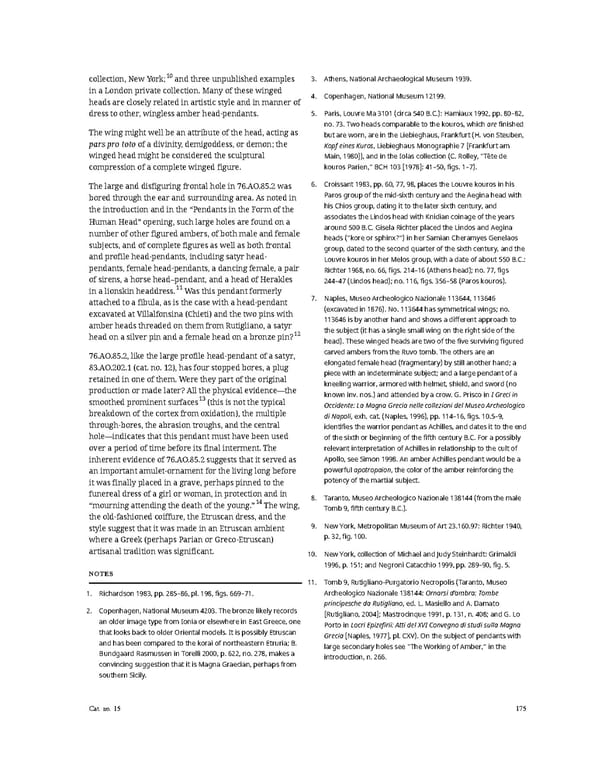collection, New York;10 and three unpublished examples 3. Athens, National Archaeological Museum 1939. in a London private collection. Many of these winged 4. Copenhagen, National Museum 12199. heads are closely related in artistic style and in manner of dress to other, wingless amber head-pendants. 5. Paris, Louvre Ma 3101 (circa 540 B.C.): Hamiaux 1992, pp. 80–82, no. 73. Two heads comparable to the kouros, which are finished The wing might well be an attribute of the head, acting as but are worn, are in the Liebieghaus, Frankfurt (H. von Steuben, pars pro toto of a divinity, demigoddess, or demon; the Kopf eines Kuros, Liebieghaus Monographie 7 [Frankfurt am winged head might be considered the sculptural Main, 1980]), and in the Iolas collection (C. Rolley, “Tête de compression of a complete winged figure. kouros Parien,” BCH 103 [1978]: 41–50, figs. 1–7). The large and disfiguring frontal hole in 76.AO.85.2 was 6. Croissant 1983, pp. 60, 77, 98, places the Louvre kouros in his bored through the ear and surrounding area. As noted in Paros group of the mid-sixth century and the Aegina head with the introduction and in the “Pendants in the Form of the his Chios group, dating it to the later sixth century, and Human Head” opening, such large holes are found on a associates the Lindos head with Knidian coinage of the years number of other figured ambers, of both male and female around 500 B.C. Gisela Richter placed the Lindos and Aegina subjects, and of complete figures as well as both frontal heads (“kore or sphinx?”) in her Samian Cheramyes Genelaos and profile head-pendants, including satyr head- group, dated to the second quarter of the sixth century, and the Louvre kouros in her Melos group, with a date of about 550 B.C.: pendants, female head-pendants, a dancing female, a pair Richter 1968, no. 66, figs. 214–16 (Athens head); no. 77, figs of sirens, a horse head–pendant, and a head of Herakles 244–47 (Lindos head); no. 116, figs. 356–58 (Paros kouros). in a lionskin headdress.11 Was this pendant formerly attached to a fibula, as is the case with a head-pendant 7. Naples, Museo Archeologico Nazionale 113644, 113646 excavated at Villalfonsina (Chieti) and the two pins with (excavated in 1876). No. 113644 has symmetrical wings; no. amber heads threaded on them from Rutigliano, a satyr 113646 is by another hand and shows a different approach to head on a silver pin and a female head on a bronze pin?12 the subject (it has a single small wing on the right side of the head). These winged heads are two of the five surviving figured 76.AO.85.2, like the large profile head-pendant of a satyr, carved ambers from the Ruvo tomb. The others are an 83.AO.202.1 (cat. no. 12), has four stopped bores, a plug elongated female head (fragmentary) by still another hand; a retained in one of them. Were they part of the original piece with an indeterminate subject; and a large pendant of a production or made later? All the physical evidence—the kneeling warrior, armored with helmet, shield, and sword (no smoothed prominent surfaces13(this is not the typical known inv. nos.) and attended by a crow. G. Prisco in I Greci in Occidente: La Magna Grecia nelle collezioni del Museo Archeologico breakdown of the cortex from oxidation), the multiple di Napoli, exh. cat. (Naples, 1996), pp. 114–16, figs. 10.5–9, through-bores, the abrasion troughs, and the central identifies the warrior pendant as Achilles, and dates it to the end hole—indicates that this pendant must have been used of the sixth or beginning of the fifth century B.C. For a possibly over a period of time before its final interment. The relevant interpretation of Achilles in relationship to the cult of inherent evidence of 76.AO.85.2 suggests that it served as Apollo, see Simon 1998. An amber Achilles pendant would be a an important amulet-ornament for the living long before powerfulapotropaion, the color of the amber reinforcing the it was finally placed in a grave, perhaps pinned to the potency of the martial subject. funereal dress of a girl or woman, in protection and in 8. Taranto, Museo Archeologico Nazionale 138144 (from the male “mourning attending the death of the young.”14 The wing, Tomb 9, fifth century B.C.). the old-fashioned coiffure, the Etruscan dress, and the style suggest that it was made in an Etruscan ambient 9. New York, Metropolitan Museum of Art 23.160.97: Richter 1940, where a Greek (perhaps Parian or Greco-Etruscan) p. 32, fig. 100. artisanal tradition was significant. 10. New York, collection of Michael and Judy Steinhardt: Grimaldi 1996, p. 151; and Negroni Catacchio 1999, pp. 289–90, fig. 5. NOTES 11. Tomb 9, Rutigliano-Purgatorio Necropolis (Taranto, Museo 1. Richardson 1983, pp. 285–86, pl. 198, figs. 669–71. Archeologico Nazionale 138144: Ornarsi d’ambra: Tombe principesche da Rutigliano, ed. L. Masiello and A. Damato 2. Copenhagen, National Museum 4203. The bronze likely records [Rutigliano, 2004]; Mastrocinque 1991, p. 131, n. 408; and G. Lo an older image type from Ionia or elsewhere in East Greece, one Porto in Locri Epizefirii: Atti del XVI Convegno di studi sulla Magna that looks back to older Oriental models. It is possibly Etruscan Grecia [Naples, 1977], pl. CXV). On the subject of pendants with and has been compared to the korai of northeastern Etruria; B. large secondary holes see “The Working of Amber,” in the Bundgaard Rasmussen inTorelli 2000, p. 622, no. 278, makes a introduction, n. 266. convincing suggestion that it is Magna Graecian, perhaps from southern Sicily. Cat. no. 15 175
 Ancient Carved Ambers in the J. Paul Getty Museum Page 184 Page 186
Ancient Carved Ambers in the J. Paul Getty Museum Page 184 Page 186